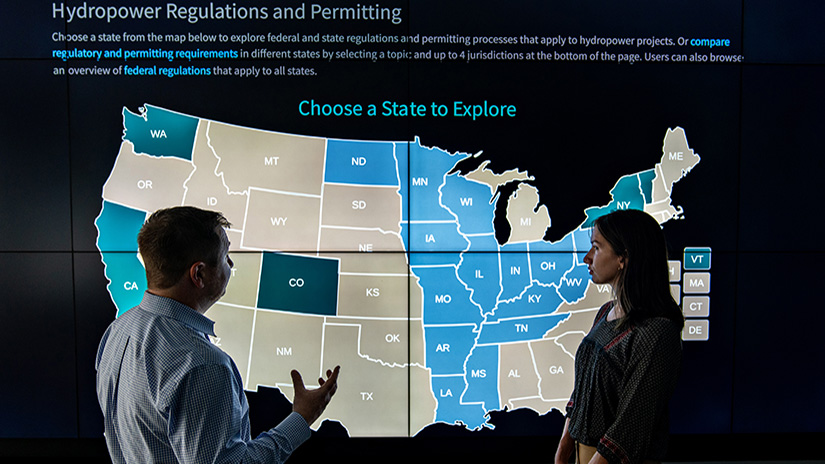New Government Regulations Could Impact Hydropower
Upcoming RAPID Updates Will Explain How Changes to Definition of U.S. Waters and Environmental Reviews Might Affect Future Hydropower Projects
Do wetlands qualify as Waters of the United States?
Not necessarily, according to a recent U.S. Supreme Court ruling, which limited which U.S. waters, including rivers, lakes, wetlands, or swampy marshes, fall under Waters of the United States (also known as WOTUS). But this is not the first time the WOTUS definition has changed.
“It’s changed countless times it seems,” said Aaron Levine, a senior legal and regulatory analyst at the National Renewable Energy Laboratory (NREL).
Levine is often neck-deep in water-related rulings. He has to be. The environmental lawyer oversees the Hydropower Regulatory and Permitting Information Desktop (RAPID) Toolkit, a curated library of the federal and state regulations that can impact new or ongoing hydropower projects—all of which touch some kind of water.
Many federal and state regulations are designed to protect our country’s wilderness, wildlife, and water quality. But they can also increase the cost, risk, and timeline to develop new hydropower projects. Right now, the country needs hydropower’s reliable energy to support the transition to clean energy (and, in so doing, protect our wilderness, wildlife, and water quality). But even the complex web of shifting regulations can slow developers down—it is too much legalese to wade through alone.
That is why Levine, along with the rest of the RAPID Toolkit team and some chipper summer interns, closely monitor regulatory shifts happening at both the federal and state levels and update the toolkit’s guidance accordingly. In 2023, he and the team have been deciphering how recent changes to the Clean Water Act (and the WOTUS definition), the National Environmental Policy Act (NEPA), and a smattering of new federal and state rules could affect the hydropower industry.
“We’re trying to capture the full suite of changes that could be in the works,” Levine said, “and aggregating all of this information into a central location.” Levine expects all updates on recently passed laws and regulations to be added to the toolkit by the end of September 2023.
The recent Supreme Court ruling, for example, determined that any wetlands adjacent to—but not continuously connected to—relatively permanent rivers, streams, lakes, or other bodies of water no longer qualify as WOTUS. That means a hydropower developer may no longer need to apply for a permit from, say, the U.S. Army Corps of Engineers to discharge dredged and fill material (often rock, sand, or soil) to stabilize the ground prior to building a transmission line to connect their facility to the grid.
Levine and team are also tracking recent and upcoming changes to NEPA, which requires federal agencies to evaluate potential environmental impacts of a project before approving any necessary permits. The RAPID Toolkit houses information on NEPA environmental reviews for 10 agencies, including those that are most often involved in hydropower development: the U.S. Department of Energy, Federal Energy Regulatory Commission, Bureau of Reclamation, U.S. Army Corps of Engineers, and U.S. Forest Service.

Under certain circumstances, multiple federal agencies could be required to complete environmental reviews under NEPA. However, recent changes to NEPA could do away with that. “The new NEPA amendments require federal agencies to all work together to develop a single environmental review document and tap one of those agencies as the lead agency,” Levine said.
The NEPA amendments will also likely require agencies to complete environmental assessments within one year and environmental impact statements within two years. (“Prior to this they were taking probably at least twice as long,” Levine said.) They must also adhere to new, shorter page limits. Both changes are intended to accelerate what tends to be a time-consuming process. Developers can now sue a federal agency if they fail to comply, and federal agencies must justify any delays to Congress.
“You're going to be held accountable by Congress, and ultimately a court could say that you have to now complete this document with X number of days,” Levine said. “The goal is not to change what needs to be reviewed. It’s trying to focus on how we still provide those same environmental considerations and protect the environment.”
Meanwhile, Levine and team will continue to watch for new rules published by the president's administration, which could happen at any time. And a team of law school interns will spend their summer scrolling through state agency websites, hunting for regulatory changes that might affect hydropower. The toolkit’s state-level pages are reviewed annually to make sure information is as up-to-date and relevant as possible. (Users can check the date stamp at the top of each page to learn how fresh the information is.)
Levine’s job is simply to hunt down, interpret, and regurgitate the most salient points from the flood of legal rulings. There is no room for opinions in this precision work, but that does not mean he is not curious to see how these shifts might help speed up hydropower development and, in so doing, the transition to a clean energy future.
“At this point, it's all speculative,” Levine said. “On paper it sounds good, but what does it look like in practice?”
As usual, he will just have to watch and wait.
The Hydropower Regulatory and Permitting Information Desktop (RAPID) Toolkit was developed with funding from the U.S. Department of Energy’s Water Power Technologies Office. Visit the toolkit for help navigating the complex system of federal and state regulations and permits.
And subscribe to the NREL water power newsletter, The Current, to make sure you do not miss a hydropower update.
Last Updated May 28, 2025
